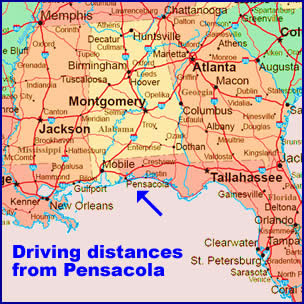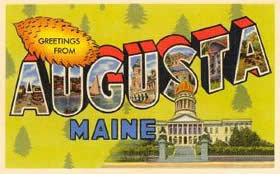 Below is a list of driving distances in miles (with estimated driving times) from Pensacola, Florida to many cities in the Southeast United States. I also included a link to tourist information for each city.
Below is a list of driving distances in miles (with estimated driving times) from Pensacola, Florida to many cities in the Southeast United States. I also included a link to tourist information for each city.Both the distances and the driving times are from DeLorme's Street Atlas USA 2006. The routes that the program suggested are based on using the fastest highways, not necessarily the most direct ones.
ALABAMA Birmingham 250 miles (4:25) • Fairhope 58 miles (1:06) • Magnolia Springs 49 miles (1:08) • Mobile 57 miles (0:57) • Montgomery 164 miles (3:06) • Troy 137 miles (3:07)
ARKANSAS Little Rock 511 miles (10:35)
FLORIDA Apalachicola (via Rts. 71 & 65) 216 miles (4:22) • Cocoa Beach 499 miles (7:58) • Destin 58 miles (1:35) • Fort Lauderdale 643 miles (10:23) • Fort Myers 582 miles (9:05) • Gainesville 332 miles (5:07) • Jacksonville 349 miles (5:23) • Key West 835 miles (15:15) • Lake City 290 miles (4:30) • Miami 668 miles (10:42) • Ocala 365 miles (5:36) • Orlando 441 miles (6:56) • Panama City Beach 131 miles (2:33) • St. Augustine 387 miles (6:07) • Tallahassee 188 miles (3:00) • Tampa 460 miles (7:05) • Venice 524 miles (8:10)
GEORGIA Atlanta 323 miles (5:32) • Blue Ridge 414 miles (7:25) • Savannah 485 miles (7:29)
LOUISIANA Lafayette 312 miles (4:55) • Lake Charles 382 miles (5:56) • New Orleans 200 miles (3:06)
MISSISSIPPI Biloxi 119 miles (1:52) • Jackson 251 miles (5:17) • Natchez 335 miles (5:44) • Summit 272 miles (4:14) •Tunica 449 miles (8:43) • Vicksburg 292 miles (5:57)
NORTH CAROLINA Asheville 555 miles (9:05)
SOUTH CAROLINA Charleston 585 miles (930) • Florence 599 miles (10:01) • Hilton Head 524 miles (8:18) • Myrtle Beach 704 miles (11:29)
TENNESSEE Chattanooga 394 miles (6:37) • Gatlinburg 544 miles (9:18) • Knoxville 503 miles (8:18) • Memphis 440 miles (8:46) • Nashville 442 miles (7:19)
TEXAS Austin 708 miles (11:12) • Dallas 697 miles (10:48) • Galveston 559 miles (8:42) • Houston 524 miles (8:06) • San Antonio 719 miles (11:04)







